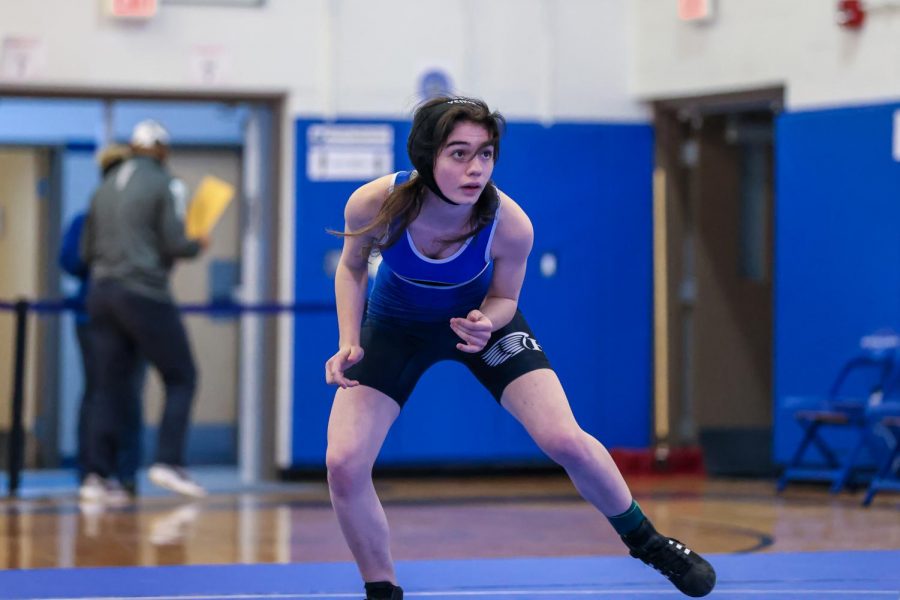Highlands girls defy gender norms one match at a time
A wrestler circles the mat, eyeing her competition. Photo courtesy of DWC Photo.
According to the National Federation of State High School Associations, female wrestlers make up about eight percent of the total 269,000 wrestlers at the high school level. Though still small, this number has nearly quadrupled over the last decade. As the number of female wrestlers increased, male participation has declined by seven and a half percent.
Many girls who wrestle in high school go on to compete in college. Female wrestlers are boosting wrestling in many schools, at a time when wrestling and other high school sports are losing popularity.
At Highlands High School, there are four girls on the wrestling team: Juniors Gracie Schlosser and Ayla Lunsford and sophomores Mckenna Oaks and Angelica Jackson.
Oaks discussed her experiences on the wrestling team, saying, “When competing, most guys will think they can beat me because I’m a girl, but I just ignore it, step on the mat, and [give it] my all to prove them wrong.”
Although girls being involved in co-ed wrestling may seem like something new, this has been around for longer than many think. In 1972, Title IX of the Federal Education Amendments banned gender discrimination in schools along with universities, which helped girls and co-ed sports have an increase in participation in the United States. Additionally, female wrestlers have been competing internationally since 1989. In 2004, there was an introduction to Olympic wrestling alongside the rise of Mixed Martial Arts (MMA), which is dominated by strong wrestlers, both female and male. Since wrestling is offered at many colleges and universities, wrestling has become popular in high school and on campus, for both genders.
The girls in wrestling have big plans for themselves when it comes to wrestling in college, specifically Oaks. She said, “I’ll continue wrestling in high school for sure and I hope to be able to wrestle on the club team when I hopefully attend West Virginia University. They may have a co-ed [team] by the time I’m there, who knows.”
However, there are some differences in the genders during wrestling that coaches and other sports professionals need to be aware of. For instance, boys and girls have different centers of gravity and differences in mass and flexibility, which can influence their moves and strategies towards victory. Along with this, gender stereotypes can influence how male coaches interact with female wrestlers, which could lead these coaches to have lower expectations for their female student-athletes and not give girls the push that they need to excel in wrestling.
Many of the girls on the wrestling team enjoy getting to be on the same wrestling team as the boys because it makes the girls work harder to prove they are just as strong as them. The girls feel right at home with the boys. When they come together as a team, gender doesn’t matter and everyone is treated equally.
Schlosser gives her opinion on why more people should join the wrestling team, saying, “Other people should join because you will learn respect and get conditioned.”
Oaks continues, encouraging why more girls should join, stating, “Girls should join wrestling because it teaches you so many life lessons. How to respect people, how to push yourself, determination, leadership, how to work and grow as a team and individual. Joining the wrestling team is the best thing I’ve ever done.”
Girls’ involvement in wrestling is very important to the improvement of the world we live in today, as sexism is still present in our society. According to a survey from BBC, in 2020, 67% of women have experienced sexism in their sport, and only 10% feel comfortable enough to report it.
These high school girls are proving gender stereotypes wrong every single time they step onto the mat.
Your donation will support the student journalists of Highlands High School. Your contribution will allow us to cover our annual website hosting costs.



